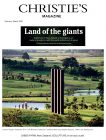2008-Eleanor Heartney Essay-ROL
In 1897, painter Paul Gauguin completed the work he considered his masterpiece; titled Where Do We Come From? What Are We? Where Are We Going?, the painting presents a monumental tableau set in a mythological version of the Tahitian paradise the artist had escaped to from France six years earlier. This work, with its representation of groups of Tahitian women at different stages of life, poses a set of existential questions that continue to resonate today. For Gauguin, the search for answers arose in the context of the wrenching changes brought on by the rise of modernity and his own desire to escape to a simpler, purer world. Today, we are in a time of equally breathtaking change. The engines driving this change are different, involving developments like globalism, the electronic revolution, and the threat of climate change, but the feeling of unrest is similar. And the questions posed by Gauguin’s painting present a template for thinking about humanity’s past and present in the midst of this ever-shifting reality. Using a very different medium, employing a vastly expanded scale, and addressing a very different world, Andrew Rogers’ Rhythms of Life represents a similar effort to explore the meanings and possibilities of human existence. This work consists of a set of twelve monumental earthwork projects inscribed on the landscapes of twelve very different geographical and cultural locations. They offer meldings of geology, mythology, archeology, and spirituality. In their depth and breadth, they reflect the spirit of Gauguin’s questions, each of which points to a particular cluster of issues. Where Do We Come From? brings up history, archeology, religion, and culture, reexamining them in light of the awareness that we exist as part of a continuum. What Are We? deals with our relation to nature, the cosmos, and other humans. Where Are We Going? seeks meaning in the inevitable change shaping our lives. In contemporary parlance, it asks how, in light of technological advance and social upheaval, we can formulate principles of ethics and moral responsibility in the service of a sustainable future. Significantly, these queries are framed in the plural, indicating that the pursuit of meaning is a communal quest rather than a search for individual salvation
or enlightenment.
Rogers’ Rhythms of Life represents a breathtakingly ambitious effort to address these fundamental questions. Rogers notes that the works in his Rhythms of Life series are “metaphors for the eternal cycle of life, growth, and all the attendant emotions that color human existence. They are optimistic symbols of life and regeneration—expressive and suggestive of human striving and introspection.” Spread across the globe and drawing on symbols from the Neolithic era to the present, these twelve Land Art projects embody Rogers’ belief in humanity’s interconnections across time and space. He adds, “It is fascinating that with modern DNA we can all see a common linkage. These symbols provide a context of history for all of us in which we are a link.” Rogers was trained as an economist and turned to art after a successful business career. He initially conceived of himself as a painter, but, deeply moved by the work of Auguste Rodin, soon turned to figurative sculpture. Eventually his bronze sculptures became abstract, expressing the internal spirit of life rather than simply recreating its outer sinews. In 1996, Rogers created the work that would become the linchpin of his subsequent Land Art projects. Titled Rhythms of Life, this bronze sculpture is composed of three elements: a ball, a gently curving geometric line, and an undulating line that intersects it. Together these elements comprise a symbolic expression of the path of life as an interplay between purposeful movements and serendipitous fluctuations. Rogers has returned repeatedly to this composition, siting versions of this sculpture in Jerusalem, California, Istanbul, and Melbourne. The original maquette of the Rhythms of Life sculpture is in the National Gallery of Australia in Canberra. The series of earthworks, which share the title of the sculpture, began somewhat by chance during a 1998 artist residency at Technion Institute of Technology in Haifa Israel, when Rogers was offered the opportunity to create an art work in the Arava Desert during a visit. His first geoglyph in 1999 was a reconstruction of the Hebrew letters for the words “To Life”—an affirmation of the life principle that runs throughout the entire Rhythms of Life series. In retrospect, Rogers notes that Israel’s Arava Desert served as the ideal starting point for this series, because it is historically regarded as the place of origin for several of the world’s major religions.
As the series has evolved, each site is host to two or more geoglyphs, the archeological term for large drawings inscribed on the ground with stones, earth, gravel, or chalk. Rogers uses local stones to create his geoglyphs, either piling them to create linear walls, or at sites where stones are less plentiful, laying them out individually to create a pattern on the landscape. Each site contains a version of the original Rhythms of Life sculpture, while the other geoglyphs comprise symbols drawn from the collective mythology or history of the local peoples. It should be noted here that their involvement is an essential component of each work. Rogers seeks local involvement in the choice of the symbol, and depends on local workers and managers for the mostly hand-built construction of the geoglyphs. The initiation or completion of each project (and sometimes both) are celebrated with a ritual performance that draws on local traditions. These range from the communal sharing of strong wine and crushed coca in Chile and a communal sacrifice of a llama in Bolivia, to a blow-out celebration involving a brass band, firecrackers, traditional dancing and singing in China. Thus these are emphatically communal enterprises;
Continue reading the full essay attached…..
